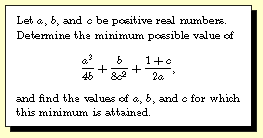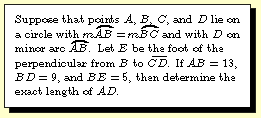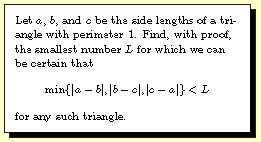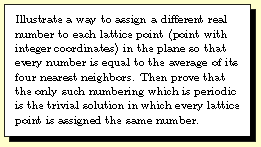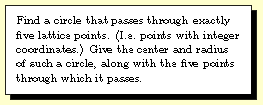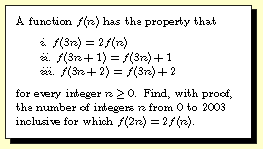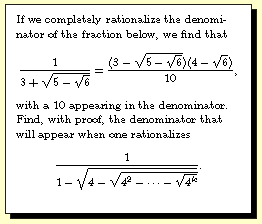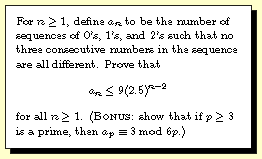... .....
|
Past Corner Problems: 2003 |
|
......
![]()
| The Problems: |
The Solvers: |
| ...... |
|
| Question: 2003-1 |
...... |
| ...... |
|
| Question: 2003-2 |
...... |
| ...... |
|
| Question: 2003-3 |
..... |
| ...... |
|
| Question: 2003-4 |
..... |
| ...... |
|
| Question: 2003-5 |
..... |
| ...... |
|
| Question: 2003-6 |
..... |
| ...... |
|
| Question: 2003-7 |
..... |
| ...... |
|
| Question: 2003-8 |
..... |
| ...... |
|
ANSWERS TO 2003
PROBLEMS
Question 2003-1
-- the minimum of 5/4 is attained if and only if
a=2, b=8, and c=2. To prove this split the third term
up into 1/2a + c/4a + c/4a, then use AM-GM on the resulting
five terms.
Question 2003-2 -- there
are many possible ways to find AD; one elegant method
involves reflecting point A over line BD to a point A'. One
then argues that A' lies on line CD. After working out
various other details, one finds that CE = EA' = ED + DA' =
ED + AD, which gives AD = 12 - 2*sqrt(14).
Question 2003-3 -- the
answer is L = 1/6, as shown in the
solution sent by the
proposer.
Question 2003-4 -- there
are many different solutions; one simple method is to
assign to the point (x,y) the number x. (So that the
middle row consists entirely of 0's, the next higher row is
all 1's, and so on.) To prove that no such numbering can be
periodic, suppose otherwise, and then consider a maximal
number in the array.
Question 2003-5 -- one such
circle is the one with center (0, 6.25) and radius
6.25, passing through the points (0,0), (5,10), (-5,10),
(6,8), and (-6,8). The proposer also mentions Schinzel's
Theorem, which states that a circle passing through n
lattice points is (x-(1/2))^2 + y^2 = (1/4)*5^(k-1) for n =
2k, and (x-(1/3))^2 + y^2 = (1/9)*5^(2k) for n = 2k+1.
Question 2003-6 -- write
n = t_0 + 3*t_1+9*t_2+...+3^k*t_k in base three, so that
each number t_i is either 0, 1, or 2. One then argues that
f(n) = t_0 + 2*t_1+4*t_2+...+2^k*t_k. The question then
amounts to finding all numbers less than 2003 = 2102022_3
(base three) with only 0's and 1's in their base three
representation. All numbers with 7 or less digits and with
only 0's and 1's work, so the answer is 128.
Question 2003-7 -- the
remarkable fact is that one ultimately obtains 1 upon
rationalizing the denominator. This may be proven by
induction.
Question 2003-8 -- First
argue that a_(n+1) = 2a_n + a_(n-1). We now proceed by
induction. The base cases n=1 and n=2 are trivial. The
inductive step is as follows:
a_(n+1) = 2a_n + a_(n-1) <= 2*9*(2.5)^(n-2) +
9*(2.5)^(n-3)
= 9*(2.5)^(n-3)*(6) < 9*(2.5)^(n-3)*(6.25) =
9*(2.5)^(n-1), as desired.
....

